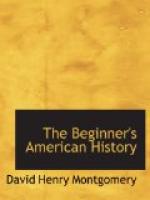77. The king of England gives Lord Baltimore part of Virginia, and names it Maryland; what Lord Baltimore paid for it.—King Charles the First of England was a good friend to Lord Baltimore; and when the settlement in Newfoundland was given up, he made him a present of an immense three-cornered piece of land in America. This piece was cut out of Virginia, north of the Potomac[1] River.
The king’s wife, who was called Queen Mary, was a French Catholic. In her honor, Charles named the country he had given Lord Baltimore, Mary Land, or Maryland. He could not have chosen a better name, because Maryland was to be a shelter for many English people who believed in the same religion that the queen did.
[Illustration: TWO INDIAN ARROWS.]
All that Lord Baltimore was to pay for Maryland, with its twelve thousand square miles of land and water, was two Indian arrows. These he agreed to send every spring to the royal palace of Windsor[2] Castle, near London.
[Illustration: PART OF WINDSOR CASTLE.]
The arrows would be worth nothing whatever to the king; but they were sent as a kind of yearly rent. They showed that, though Lord Baltimore had the use of Maryland, and could do pretty much as he pleased with it, still the king did not give up all control of it. In Virginia and in New England the king had granted all land to companies of persons, and he had been particular to tell them just what they must or must not do; but he gave Maryland to one man only. More than this, he promised to let Lord Baltimore have his own way in everything, so long as he made no laws in Maryland which should be contrary to the laws of England. So Lord Baltimore had greater privileges than any other holder of land in America at that time.
[Footnote 1: Potomac (Po-to’mak): see map, paragraph 140.]
[Footnote 2: Windsor (Win’zor).]
78. Lord Baltimore dies; his son sends emigrants to Maryland; the landing; the Indians; St. Mary’s.—Lord Baltimore died before he could get ready to come to America. His eldest son then became Lord Baltimore. He sent over a number of emigrants; part of them were Catholics, and part were Protestants: all of them were to have equal rights in Maryland. In the spring of 1634, these people landed on a little island near the mouth of the Potomac River. There they cut down a tree, and made a large cross of it; then, kneeling round that cross, they all joined in prayer to God for their safe journey.
[Illustration: THE LANDING IN MARYLAND.]
A little later, they landed on the shore of the river. There they met Indians. Under a huge mulberry-tree they bargained with the Indians for a place to build a town, and paid for the land in hatchets, knives, and beads.
The Indians were greatly astonished at the size of the ship in which the white men came. They thought that it was made like their canoes, out of the trunk of a tree hollowed out, and they wondered where the English could have found a tree big enough to make it.




